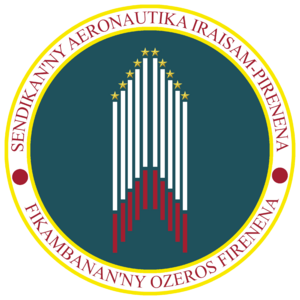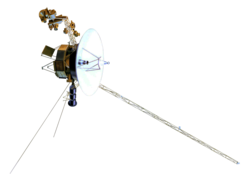International Aeronautical Union: Difference between revisions
Hierophant (talk | contribs) No edit summary |
mNo edit summary |
||
| Line 19: | Line 19: | ||
|headquarters = [[Congvat]], [[Daobac]] | |headquarters = [[Congvat]], [[Daobac]] | ||
|coordinates = | |coordinates = | ||
|spaceport = | |spaceport = {{unbulleted list | ||
| {{flagicon|Daobac}} Võ Bảo Vy Space Center | |||
| {{flagicon|Kajera}} TBD Space Center | |||
| {{flagicon|Pulacan}} TBD Space Center | |||
| {{flagicon|Pulau Keramat}} TBD Space Center | |||
}} | |||
|seal = File: Seal_of_the_IAU.png | |seal = File: Seal_of_the_IAU.png | ||
|seal_size = 300px | |seal_size = 300px | ||
| Line 26: | Line 31: | ||
|caption = IAU Headquarters at [[Congvat]], [[Daobac]] | |caption = IAU Headquarters at [[Congvat]], [[Daobac]] | ||
|acronym = SAIP | |acronym = SAIP | ||
|established = | |established = {{Start date and age|1970|1|31}} | ||
|employees = TBD | |employees = TBD | ||
|administrator = [[Director]] XXX | |administrator = [[Director]] XXX | ||
Revision as of 11:01, 4 December 2022
Sendikan'ny Aeronautika Iraisam-Pirenena (Nylele) | |
 Seal of the IAU | |
 | |
| Abbreviation | SAIP |
|---|---|
| Formation | January 31, 1970 |
| Headquarters | Congvat, Daobac |
Official language | Nylele |
Administrator | Director XXX |
Parent organisation | |
Budget | |
Staff | TBD |
The International Aeronautical Union (Nylele: Sendikan'ny Aeronautika Iraisam-Pirenena (SAIP), commonly abbreviated as the IAU, is an independent agency of the Association of Ozeros Nations (AON) that is responsible for pioneering and coordinating the activities of its member states civilian space program. The IAU was founded in XXXX, is headquartered in Congvat and has a permanent staff of XXXX people. Member states of the AON contribute to the IAU in various ways. Some contribute solely by providing funding for the organization, others provide various facilities related to the study of space exploration such as launch, and vehicle manufacturing facilities, observatories and research labs. Others nations who do not have much in the way of extra funds for government spending, contribute by providing land that is suitable for IAU sponsored launch service providers to lease, construct and operate launch or research facilities in their countries. The IAU's primary launch vehicles include the Phoenix 1 MLV and Phoenix 2 HLV rockets, both of which were designed by the Daobac Space Corporation as well as manufactured and funded by its various partners both within the IAU and the Joint Space Agency. The IAU also utilizes the XXX, XXX and XXX launch vehicles from XXX, XXX and XXX. The establishment of the IAU has had a positive contribution for member states that both have and do not have launch capability. For those that have launch capability, no single nation or organizaiton is capable of drumming the funding, political will nor public support for large scale and long term projects. The presence of the IAU allows its member states to tap into a larger pool of resources, of which both expertise and cost can be shared among one another. For states that do not have launch capability they are now able to more easily have and request access to launch their own satellites from member states that do have that capability. All member states are also able to utilize IAU sponsored research facilities for academic and development purposes such as observatories, research laboratories and manufacturing facilities. The IAU is most well known for providing commercial launch services for both member and non-member states as well as its unamnned probe programs.
History
Establishment
Early Years
Contemporary Era
Management
Structure
Organization
Membership
Programmes
Active
Explorer Program
The Explorer Program is an ongoing scientific and space exploration program of the IAU that utilizes a variety of space probes that travels thorugh space and collect scientific data. The Explorer Program is the IAU's longest active program, having been in operation since 1986 and is considered as one of its most best and well known scientific programs. Explorer probes have been sent to explore Ajax's moon, as well as both the inner and outer planets of the Solar System. The first Explorer probe, Explorer 1, was launched in July 1986 on board a Dragon 3 rocket and is widely considered to be a test run of the Explorer probes in general. Throughout its mission window from July to October, the Explorer 1 probe measured various phenomenas such as magnetic fields, solar flare particles and ionization of the interplanetary region. Its success prompted the IAU to provide further funding and in the next four years, the Explorer 2, 3, 4, 5 and 7 probes were launched as a series of space weather stations that monitors and observes solar wind, cosmic rays and magnetic fields. Its most successful and famous probes however are the Explorer 10 and 11 probes. These two probes were launched to take advantage of a favorable alignment of the outer planets which allowed the probes to visit all the gas giants beyond the asteroid belt and send data back to Earth. Explorer 10 was launched on the 7th of April 1997 and Explorer 11 followed one month later on May 1997. To date, the twin probes are among the furthest man made objects sent into outer space. In the modern era, the Explorer program is centered around the exploration of the inner planets for evidence that some of the inner planets may have supported life in the past. Its most recent project is the Mars Explorer space probe which sent a rover, the Inquiry rover, to land on the surface of mars and conduct various scientific experiments on the surface, while the Mars Explorer probe continued to gather data of Mars from orbit.
